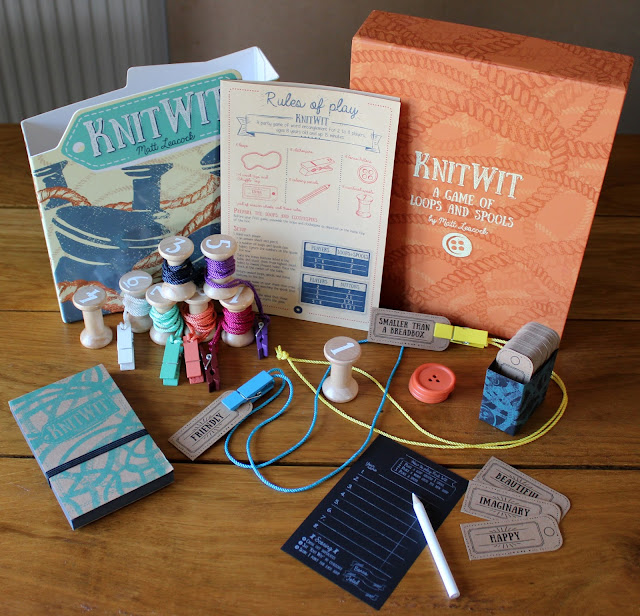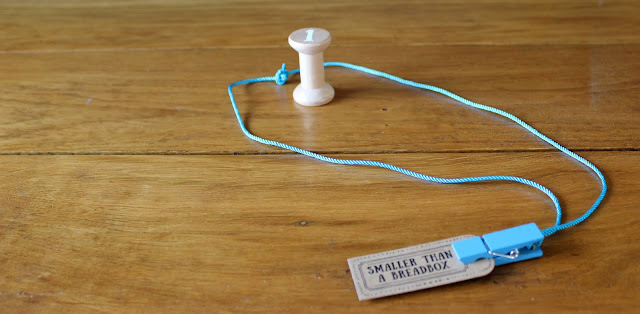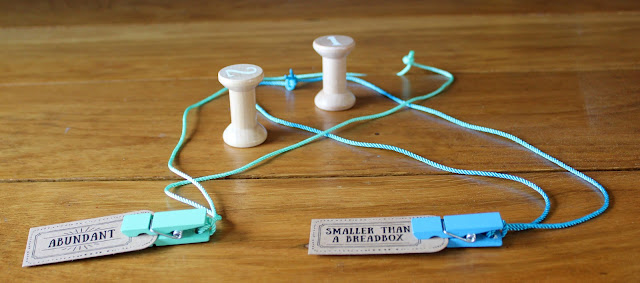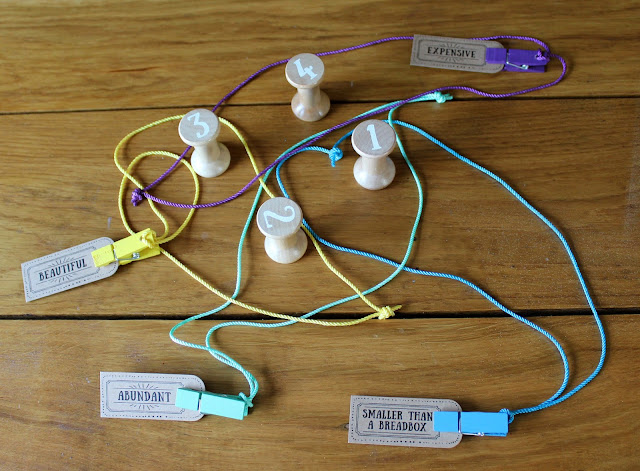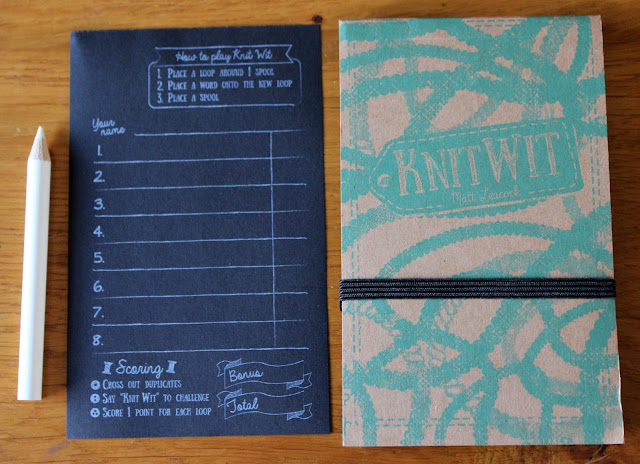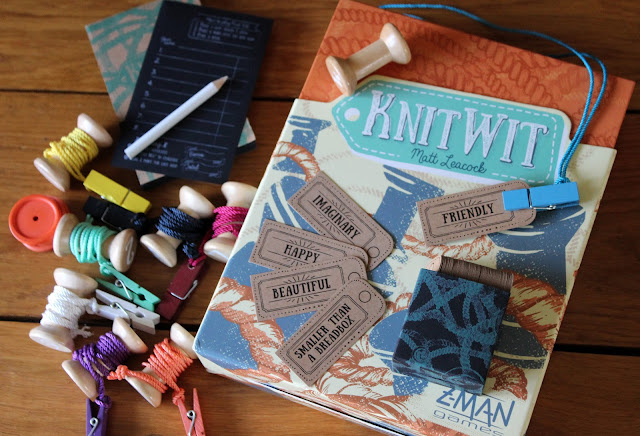Knit Wit is a word game for 2-8 players where they create Venn diagrams out of loops of coloured string, each of which has a word attached to it. Spools are placed at various overlaps in the diagram and players race against each other to think of a word or phrase for each spool, defined by the words looped around them.
Opening the beautifully designed box, you'll find a collection of spools wrapped in colourful string, a box full of word tags, some chunky buttons and a chalkboard-style scoring pad with matching white pencils. This game looks amazing, like someone emptied a small craft shop onto the table, which is always going to be popular with me:
There's a little bit of assembly required to attach clothes pegs to the various coloured loops, but then you're ready to go (even more so because the rules are quick to read and easy to explain).
Each game is broken into three chunks: building your loop-and-spool Venn diagram ('knitting'), thinking of your answers, and scoring.
Knit
Building the diagram is nice and straightforward, even though it's a big tangled mess by the time you're done. Each player is given a number of loops and spools (depending on player count). The first player lays down a loop, draws a word 'tag', attaches it to the clothes peg on their loop and then places a spool within the loop.Players then take it in turns to lay loops over exactly one spool and then place a spool in one of the newly created spaces.
This continues - loop, word, spool, repeat - until all 8 spools have been used up and the design is complete, like so:
 |
| Argh... |
Answer
Players then have to think of answers for each numbered spool as quickly as possible and write them on their answer sheet. Answers must be described by all of the words attached to loops surrounding the spool you're working on. They can be as sensible or as far-fetched as you like, provided you think you can argue your case with your friends during the scoring round!Here's my dubiously un-imaginative example answer for the design above:
- Moving, abundant, imaginary, smaller than a breadbox - Fairies
- Beautiful, abundant - Flowers
- Beautiful, heavy, expensive - Aston Martin Vanquish
- Pointy, expensive - Diamonds
- Imaginary, smaller than a breadbox - The One Ring
- Pointy - Stick
- Heavy - Mountain
- Moving - Giraffe
The first person to finish answering grabs the top button from a small stack in the middle of the table. These are worth bonus points based on the number of holes in the button, with the best one on top, decreasing in value down the pile. When the last bonus button is taken, everyone else has to stop answering and it's time to score.
Score
Everyone takes it in turns to read out their answers for each spool. Answers are worth points equivalent to the number of loops around that spool. Any duplicate answers are crossed out and score zero. The person with the highest score, after adding on any points from their bonus button, is the winner!For each word or phrase you read out, everyone else has the chance to say 'Knit Wit' and call you out on your potentially rubbish answer. You then have 10 seconds to defend yourself, after which everyone else votes on whether or not you'll get points. This was where the most fun came into Knit Wit for us; reading out our answers and haggling over whether or not they were allowable, given how vague and silly some of them were.
I'm not sure this game would be much fun at all if you took it super-seriously and stuck to strict definitions. The rulebook gives an example answer for 'cheap', 'wooden' and 'historical' as 'discount Roman kindling' and I think this is exactly the sort of creative, fun thinking you need to get the most out of this game. By its nature the game is very vague over what's acceptable or not, but that's where voting as a group comes in and being able to plead your case in a convincing (or amusing) manner is so important.
There are going to be people that don't like this lack of structure, so having an idea of how well this will go down with your group is important - although I'm sure the same can be said of most games!
It also might not be the best game for people who get stressed about being pressured to be creative; I say this as a person who finds it really tough trying to give clues in Mysterium or link words in Codenames. Whilst I still love these games and am determined to do better, my imagination all too often lets me down and I get a similar feeling trying to come up with fun things to answer in Knit Wit. I know this could worry some people and might put them off.
The only real negative about the game itself that came up was the name. Yes, it sort of involves knitting, but only under the broadest definition of combining two loops rather than anything related to needles and wool.
As a 'hobby' board gamer I would pick this up immediately ('shut-up-and-take-my-money' style) because it has Matt Leacock's name on the box, but for my non-gamer work friends (who would just laugh at me for having favourite board game designers) this looks like (and I quote) 'some knitting game' that would pass them by un-noticed. This is such a shame because they love other word games (like Codenames, a recent hit during the NSPCC Big Board Game Day), they liked the components and they had a great time playing, so I can't help but think that with a different slant on it Knit Wit could have a wider mass-market appeal.
Still, I'm not the massively successful board game publisher, and I'm sure Z-Man Games knows what they're doing - although I do love the original prototype name, 'Venntangled', which seems so much more descriptive of the game.
Overall, I found Knit Wit to be an enjoyable word game with high production values, fast setup and play time (games last a speedy 15 minutes) and a theme close to my craftly heart. Setting up the design is tactile, colourful and fun, racing to choose your answers is tense and arguing about them afterwards can be hilarious. 'No, Stonehenge doesn't count as 'intangible' just because you're not *allowed* to touch it!', and so forth.
In his interview for Z-Man Games here, Matt specifically refers to Knit Wit as a social game rather than a party game - something to break out after a nice dinner with friends if you're not in the mood for rules explanations and strategy. I think that's a great description; lighter, but still thinky and challenging.
Knit Wit
Designer: Matt Leacock
Publisher: Z-Man Games
Players: 2-8
Age: 8+
Cost: RRP £29.99 [Take a look at Esdevium's store locator to find a local brick-and-mortar retailer in Europe]
If you enjoyed this post perhaps you could take a look at my Facebook page and leave a like or come and say hello on my Twitter or Instagram feeds!


